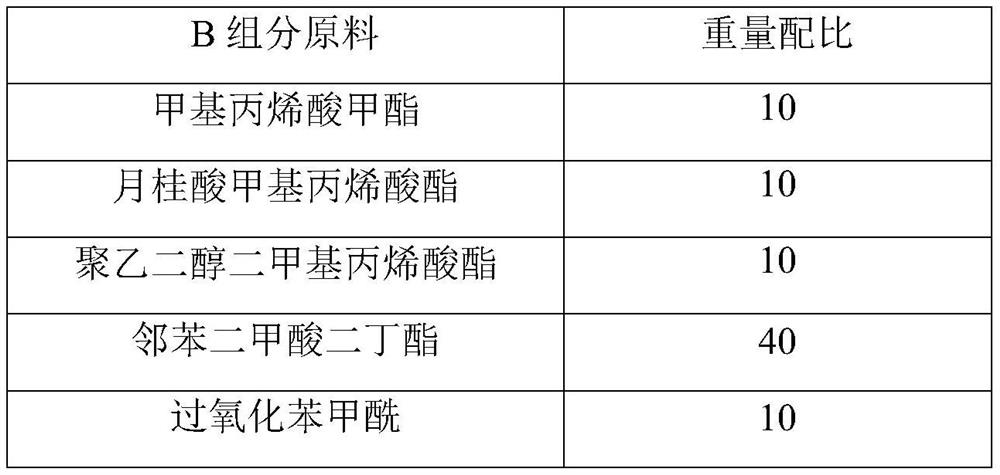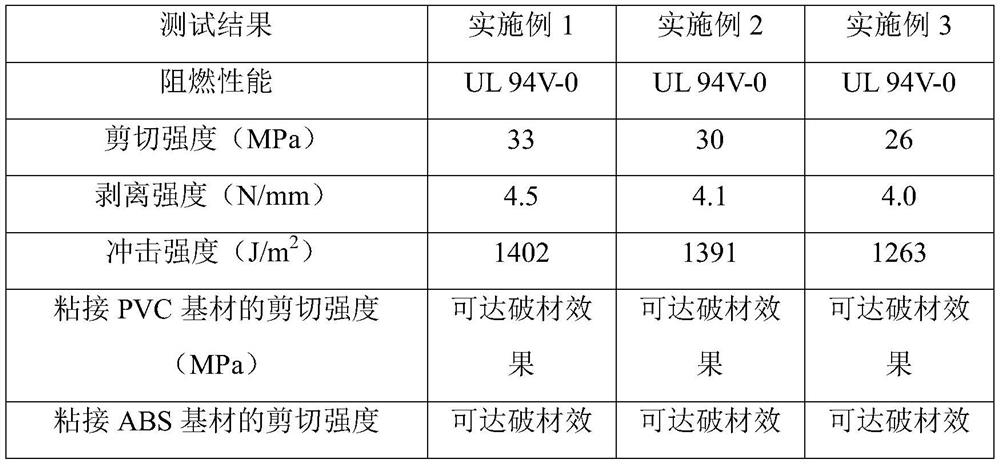Bi-component halogen-free flame-retardant acrylate structural adhesive and preparation method thereof
An acrylate and acrylate technology, applied in the field of two-component halogen-free flame retardant acrylate structural adhesive and its preparation, can solve problems such as limitations, and achieve excellent flame retardant performance, good extrudability and thixotropy, and stability. Excellent effect
- Summary
- Abstract
- Description
- Claims
- Application Information
AI Technical Summary
Problems solved by technology
Method used
Image
Examples
Embodiment 1
[0046] Example 1, a halogen-free flame-retardant acrylate structural adhesive, which is composed of two components A and B, and the volume ratio of the A and B components is 10:1.
[0047] The acrylic type monomer of component A is selected from methyl methacrylate, lauric acid methacrylate, and polyethylene glycol dimethacrylate; the halogen-free flame retardant is selected from tricumyl phosphate; The toughening agent is selected from MBS resin; the stabilizer is selected from hydroquinone and disodium edetate; the accelerator is selected from triphenylphosphine; the coupling agent is selected from gamma-glycidoxypropyl trisodium Methylsilane. The specific component contents are shown in Table 1.
[0048] Table 1
[0049] A component raw material Weight ratio Methyl methacrylate 20 Lauric acid methacrylate 20 polyethylene glycol dimethacrylate 20 tricumyl phosphate 20 MBS resin 15 Quinol 2.5 Disodium edetate 2.5 Tri...
Embodiment 2
[0058] Example 2, a halogen-free flame-retardant acrylate structural adhesive, which is composed of two components A and B, and the volume ratio of the A and B components is 10:1.
[0059] The acrylic monomers of component A are selected from acrylate stearate, isodecyl acrylate, and polyurethane acrylate; the halogen-free flame retardant is selected from cyclic phosphate; the toughening agent is selected from ABS resin; the stable The agent selects p-benzoquinone and tetrasodium edetate; the accelerator selects triethylamine; the coupling agent selects ν-aminopropyltriethoxysilane. The specific component contents are shown in Table 3.
[0060] table 3
[0061] A component raw material Weight ratio Acrylic Stearate 15 Isodecyl acrylate 15 urethane acrylate 15 Cyclic Phosphates 15 ABS resin 15 Benzoquinone 2 Tetrasodium EDTA 2 Triethylamine 2 ν-Aminopropyltriethoxysilane 1.5
[0062] The acrylic type monomer...
Embodiment 3
[0070] A halogen-free acrylate structural adhesive, consisting of two components A and B, the volume ratio of the A and B components is 10:1.
[0071] The acrylic type monomer of A component selects lauryl methacrylate, triethylene glycol dimethacrylate, polyester acrylate; Described halogen-free flame retardant selects bisphenol A bis(diphenyl phosphate); The toughening agent is selected from SBS resin; the stabilizer is selected from p-hydroxyanisole, disodium edetate; the accelerator is selected from dimethylaniline; Oxysilane. The specific component contents are shown in Table 5.
[0072] table 5
[0073] A component raw material Weight ratio lauryl methacrylate 16 Triethylene glycol dimethacrylate 16 polyester acrylate 16 Bisphenol A bis(diphenyl phosphate) 16 SBS resin 16 p-Hydroxyanisole 2 Disodium edetate 2 Dimethylaniline 5 Triaminofunctional Propyltrimethoxysilane 1.8
[0074] The acrylic monomer...
PUM
 Login to View More
Login to View More Abstract
Description
Claims
Application Information
 Login to View More
Login to View More - Generate Ideas
- Intellectual Property
- Life Sciences
- Materials
- Tech Scout
- Unparalleled Data Quality
- Higher Quality Content
- 60% Fewer Hallucinations
Browse by: Latest US Patents, China's latest patents, Technical Efficacy Thesaurus, Application Domain, Technology Topic, Popular Technical Reports.
© 2025 PatSnap. All rights reserved.Legal|Privacy policy|Modern Slavery Act Transparency Statement|Sitemap|About US| Contact US: help@patsnap.com



